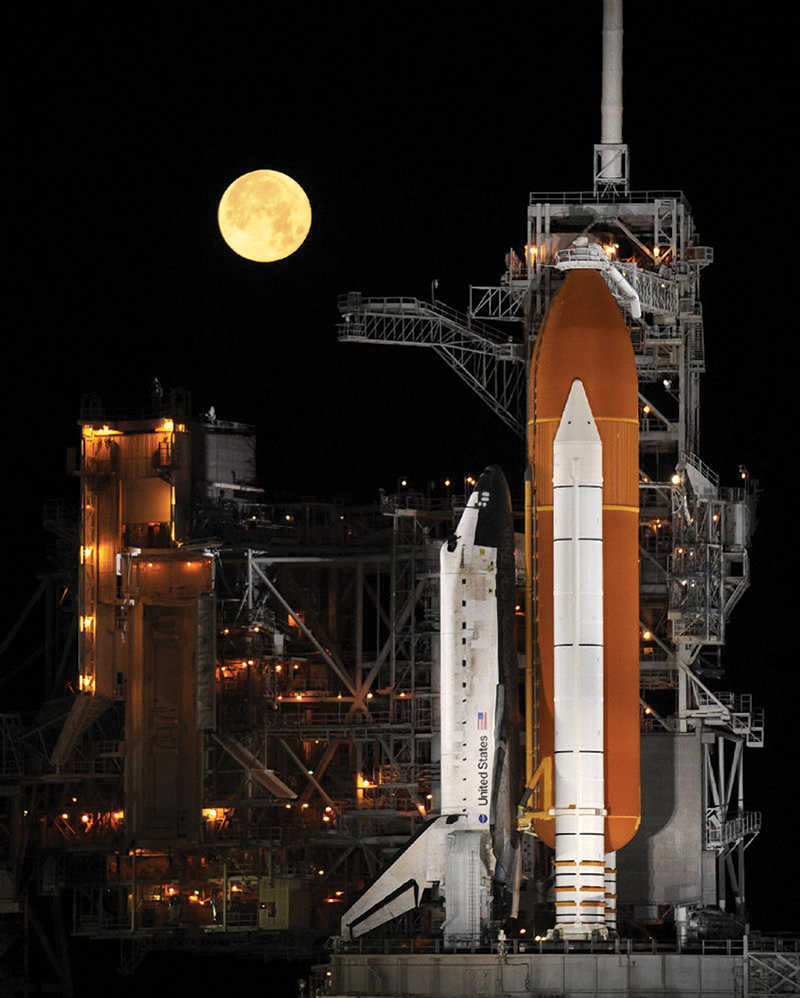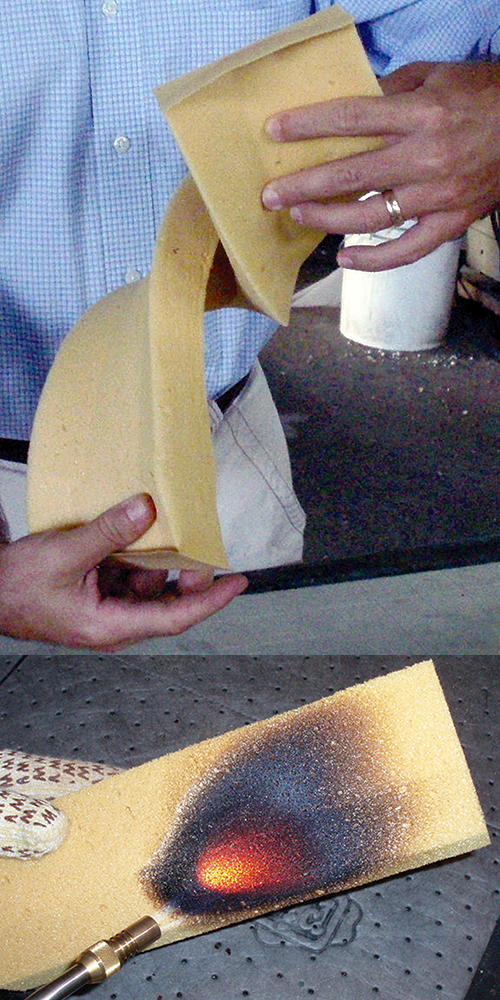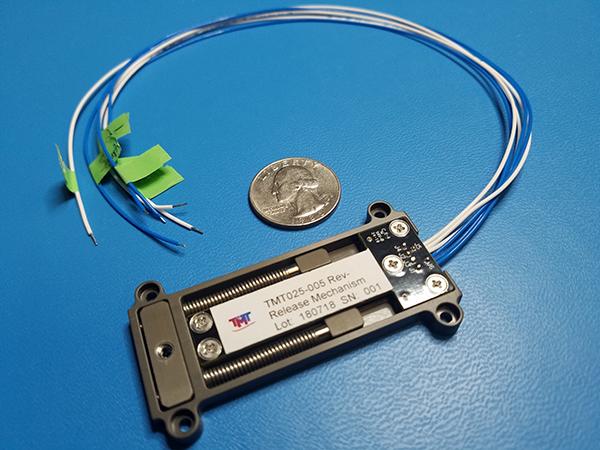
Insulating Foams Save Money, Increase Safety
Originating Technology/NASA Contribution
Researchers at the Advanced Materials and Processing Branch at Langley Research Center created a superior polyimide foam as insulation for reusable cryogenic propellant tanks on the space shuttle. At the time, the foam insulation on the tanks had a limited lifetime: one launch, which did not suit NASA’s need for reusable launch systems.
The foam on the shuttle’s external tanks needed to insulate the super-cooled liquid propellant, preventing ice from forming on the tanks and surrounding areas and posing catastrophic risk from debris during launch. The insulation also needed to be able to withstand the high temperatures that the tanks would experience during ignition and launch. The researchers named their new foam TEEK.
A partnership with a small business in Florida improved the chemical structure of the NASA-developed foam, leading to a new product, FPF-44 with commercial applications in the boat-building business, as well as further applications within the Space Program. The partnership also earned NASA scientists, Roberto J. Cano, Brian J. Jensen, and Erik S. Weiser, as well as their industry counterpart, Juan Miguel Vazquez, the coveted designation of “NASA Commercial Invention of the Year.”
Partnership
A small Hialeah, Florida-based business, PolyuMAC Inc., was looking for advanced foams to use in the customized manufacturing of acoustical and thermal insulation. PolyuMAC is a state-of-the-art manufacturer of foams for use in the marine industry. One of the company’s customers had requested newer, advanced materials for use on U.S. Navy ships. The goal, then, was to find an advanced, insulating material—lighter weight, manufacturable in-house, easy to work with, increased insulating capabilities, and affordable. The hunt was on for better foam.
During this search, Juan Miguel Vazquez, new product development lead as well as founder and president of PolyuMAC, came across information about the TEEK foam developed at Langley. Vazquez read about TEEK and contacted Langley for samples and technical data sheets.
He reviewed the materials and began his own testing, investigating the foam’s properties. He determined, however, that TEEK was not the right density for his needed applications, and furthermore, producing the material in the large quantities he needed would have been cost-prohibitive. Rather than dismiss the endeavor altogether, though, he contacted the inventors and asked for help tweaking the TEEK chemistry to bring it more in line with his company’s needs. They agreed, and he licensed the foam from NASA to begin the modifications. After multiple visits between the company’s laboratory and the NASA field center, the researchers had made the foam lighter in weight and cheaper to produce. They named this new generation of foam FPF-44, and the patent is now held by the three Langley scientists and Vazquez. NASA tested FPF-44 at the White Sands Test Facility, a rocket test site in the dunes of New Mexico operated by the Johnson Space Center. There, scientists simulated launch facility conditions to test for ice mitigation on the liquid oxygen feedline on the space shuttle’s external fuel tank. The specific goal was to prove that FPF-44 was a viable option for addressing a chief safety concern—a gap between the liquid oxygen feedline and the external tank support brackets, which is exposed to cryogenic temperatures, allowing moisture to collect on the oxygen tank and turn to ice. During tanking, de-tanking, and launch, the feedline articulates, opening and closing the small gap. The insulation needed to be flexible to allow for the articulation of the exposed metal parts to prevent ice from forming. The Langley-PolyuMAC team thermal-formed the foam into the exact shape needed for that gap, with added flexibility to keep it in place and prevent damage when the feedline moved. The success of this test makes it a candidate for future shuttle applications and insulation on next-generation space vehicles. The NASA-PolyuMAC team is continuing to collaborate on the foam, trying to further reduce density while maintaining its insulating properties. Future applications could include the next generation of commercial aircraft. Commercial aircraft, which currently use fiberglass as an acoustic sound absorber, could perhaps benefit from the next-generation foam, since it has improved handle-ability while providing the same—if not improved—insulating qualities. The test will be if the scientists can lower the density of the foam enough to make it a compelling alternative and if they can develop manufacturing processes capable of accommodating the scale and quantity necessary to infiltrate the large commercial aircraft industry.
Product Outcome
Commercial production of the joint NASA-PolyuMAC foam began in summer 2007, with the company marketing the foam under the trade name Polyshield. The commercialized version offers the same qualities as the NASA next-generation, high performance, flexible polyimide foam, and shows promise for use on watercraft, aircraft, spacecraft, electronics and electrical products, automobiles and automotive products, recreation equipment, and building and construction materials.
Consumers appreciate its flame retardant qualities, thermal insulation and acoustic insulation factors, and the weight reduction it provides, but the chief advantage Polyshield has over the TEEK foam is that it is roughly one-fifth the cost to manufacture. The durable polyimide foam is formed at room temperature and then cured using large microwaves, which reduces costs and increases the company’s production rates. The finished product can be flexible or rigid, structural or non-structural, and is always highly durable. This affordable insulating foam can also be applied to gaskets and seals, vibration damping pads, spacers in adhesives and sealants, extenders, and flow-leveling aids.
The products provide excellent insulation for sound, cryogenics, and heat, and can be used for fire protection. In fact, one of the chief advantages of this material is that, while it holds at very high temperatures, if it does burn, it will not produce smoke or harmful byproducts, a critical concern on boats, submarines, airplanes, and other contained environments.
While the company has the capacity to thermal-form the material into any shape required by clients, it typically provides sheets of the foam to customers, who then cut and shape it as needed for their specific applications. The user can then cover it with various cloths. PolyuMAC will, on demand, make specially fitted shapes, and densities can be tailored according to the intended use.

The commercial Polyshield foam is flexible, flame-retardant, and provides excellent thermal and acoustical insulating properties.

Engineers at Langley Research Center developed insulating foam for the space shuttle’s external fuel tanks.













